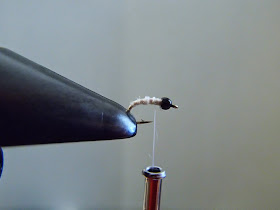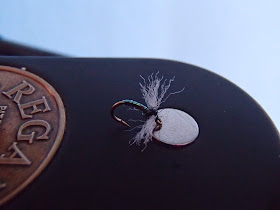Wow, what happened to July, it's August already. The fishing is just starting to pick up on the Schuylkill, now that we finally have good water conditions. I have been out a few times so far, but the next three months are full of trips. Casey had a trip the other morning and they put a monster in the boat with a lot of medium sizes ones. The yearlings are eating well, so look for lots of fish in the 10-12" range. The later we get into the season, the larger they will get.
Tully fishing has been awesome, tricos are all over the place and they are still eating flying ants. Look at the water temps before heading out, and if you do go out try to be off the water by noon. After that you run the risk of killing fish because of High water temps. Spent wing caddis have also been a sure thing mixed in with trico spinners.
Thursday, July 31, 2014
Friday, July 18, 2014
Featured Fly - Sunken Trico
Here is another trico pattern, I wouldn't say its my invention, but it does have a few twists to the traditional sunken trico in the shop. It has worked wonders for me the past few days. I fish it under a pop emerger or a CDC Caddis, only about 6-8 inches below the dry fly.
Step 3: Thinly dub the body, leaving about a hook eye space behind the bead.
Step 4: Wrap the tinsel forward, making a nice segmented body.
Step 5: Tie in the antron for the wing. I tie this in with figure 8 thread wraps.
Step 6: Trim the wings to the length you prefer. For the sunken tricos I like the wings a little sparse.
Step 7: Using the same figure 8 thread wraps, dub the thorax with the black dubbing.
Step 8: Whip finish and Cut off!
Finished Fly:
Here are the two color ways, male sunken and female sunken
Materials:
Hook: 2488 sz, 20-26
Bead: Tungsten Bomb Beads sz. 1/16th - Black
Thread: 14/0 Veevus - White or Black
Rib: Pearl Tinsel sz. Small
Abdomen: Superfine Dubbing - White or Black
Thorax: Superfine Dubbing - Black
Wing: Antron Yarn - White, Lt Grey, or Dun
Step 1: Slide the bead on the hook and place in the vise.
Step 2: Make a thread base, tying in the tinsel as you go back.
Step 3: Thinly dub the body, leaving about a hook eye space behind the bead.
Step 4: Wrap the tinsel forward, making a nice segmented body.
Step 5: Tie in the antron for the wing. I tie this in with figure 8 thread wraps.
Step 6: Trim the wings to the length you prefer. For the sunken tricos I like the wings a little sparse.
Step 7: Using the same figure 8 thread wraps, dub the thorax with the black dubbing.
Step 8: Whip finish and Cut off!
Finished Fly:
Here are the two color ways, male sunken and female sunken
Sunday, July 13, 2014
A Good Day - Tully
Finally, I went trout fishing. It's been a while since I've fished my
home waters; the Tully was fishing awesome this morning. Spent caddis and trico
spinners were all over the place, with steady action from all trout. It was a
little slower down river, so I started the day off nymphing, small pheasant
tails, and caddis pupa. After a while, I headed up stream to find some open
water around the water works. The fishing was awesome, but with low water comes
picky fish and small tippet, 8x to the dries and 6x to the nymphs. Play your
fish smart and get them in and out as quick as possible. The temp gauge is
busted right now, so while I was out, I checked the temps everywhere I went.
It's getting warm out there, mid 60's so please be mindful of the temps when
fishing from here on out.
Friday, July 11, 2014
Featured Fly - Glass Butt Trico Spinner
Ok, so because I was so bad with the featured flies last month, I am going to try to over load you this month. Fishing and Tying has taken a back seat to life the past month or so, but its smallmouth and trico season, so let the fishing and tying begin! This is a simple fly that was shown to me by Wes years ago, it has be tested and proven. So I wanted to share it with everyone, Enjoy.
Step 2: Keeping the wraps tight, bring the thread forward about 3/4 of the hook shank.
Step 3: Wrap the tinsel forward, keeping the wraps tight. Tie off and cut excess.
Step 4: Take a small piece of poly yearn, and tie it in, you can trim to size once they it is secure.
Step 5: Dub the thorax, you do no need a lot of dubbing for this.
Step 6: Whip finish and cut thread.
Materials:
Hook: TMC 2488 sz 20-28
Thread: UNI Thread 8/0 - Black
Flash Butt: Pearl Tinsel - Small
Wing: Poly Floating Yarn - Lt Grey, White, or Med Grey
Thorax: Superfine or Antron - Black
Step 1: Make a tight thread base, tying in the tinsel as you go back.
Step 2: Keeping the wraps tight, bring the thread forward about 3/4 of the hook shank.
Step 3: Wrap the tinsel forward, keeping the wraps tight. Tie off and cut excess.
Step 4: Take a small piece of poly yearn, and tie it in, you can trim to size once they it is secure.
Step 5: Dub the thorax, you do no need a lot of dubbing for this.
Step 6: Whip finish and cut thread.
Wednesday, July 9, 2014
Featured Fly - Lite Brite Ant
Here is a ant pattern that I came up with after having a conversation with a customer a few weeks back. Yup thats right a few weeks back, sorry for the delay, and lack of posting. This is an awesome little, or big ant pattern, it floats high and seems to get the trouts attention nicely.
Step 2: Make a small dubbing ball, then wrap the thread forward. This will make the middle of the fly.
Step 3: Choose about 6 strands of flash and tie in. Leaving about a 1/4 of the hook open.
Step 4: Next get your web wing out and cut a small rectangle, about the length of the hook shank. trim the edges to make a tapered wing.
Step 5: Tie in the wing, just over the flash.
Step 6: Strip and stack one cdc feather. Tie it in and trim excess off.
Step 7: Make another dubbing ball, this will form the head.
Step 8: Whip finish and start piling them up.
Materials:
Hook: TMC 100 sz. 12-18
Thread: UNI Thread - Color to Match Dubbing
Body: Ice Dub - Black, Copper, Red
Flash: Flashabou Accent - Pearl or Opal
Under Wing: Web Wing - Brown or Grey
Wing: CDC - Natural Brown or Med Dun
Step 1: Make a thread base.
Step 2: Make a small dubbing ball, then wrap the thread forward. This will make the middle of the fly.
Step 3: Choose about 6 strands of flash and tie in. Leaving about a 1/4 of the hook open.
Step 4: Next get your web wing out and cut a small rectangle, about the length of the hook shank. trim the edges to make a tapered wing.
Step 6: Strip and stack one cdc feather. Tie it in and trim excess off.
Step 7: Make another dubbing ball, this will form the head.
Step 8: Whip finish and start piling them up.
















































